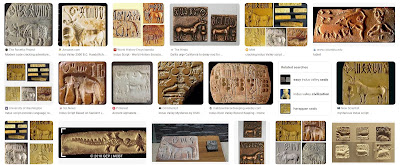Deciphering Indus script:
PASUPATHI SEAL - (Mahayogi seal, Proto-Shiva seal )
Dr. N. Ganesan (NASA and US Airforce Scientist) - Troves of information - intrigued me into historic language research and was reading extensively on these subjects.
He is from Pollachi, where I am also from. He is admin of our Tamil Circle (தமிழ் வட்டம்) group and he solves many ancient Tamil word meaning, etymology, history and many other language related enquiries. He is also well versed in Tamil who could write Venba immediately. Recently he was awarded Kalingarayar Award at Thiru. N. Mahalingam NM100 Centennial function.
Dr. Ganesan is also involved in Houston Tamil Studies Chair:
Dr. N. Ganesan has published a paper on:
A Dravidian Etymology for Makra - Crocodile
Gharial
It led me to get interest in Indus Valley topics and search on various available information on Indus.
It is always great to understand historical scripts.
One of them that intrigues more is the Indus Valley Scripts.
Some information on Indus valley and seals:
Time Line Source: World History
c.7000 BCE - Evidence of religious practices in the Indus Valley
c. 7000 BCE - c. 600 BCE - The Indus Valley (or Harappan) Civilization.
c. 4000 BCE - Farming settlements are established in the Indus Valley.
c. 3000 BCE - First signs of urbanization in the Indus Valley.
c. 3000 BCE - The Aryans - nomadic northerners from central Asia - possibly begin to migrate into the Indus Valley in an early phase of migration.
c. 2800 BCE - c. 1900 BCE - The rise of the great Indian cities of Mohenjo Daro and Harappa.
c. 2600 BCE - Hundreds of towns and cities are established throughout the Indus Valley.
c. 2500 BCE - Earliest use of the Indus Script.
c. 2000 BCE - c. 1500 BCE - The Aryans expand into the Ganges valley in India.
530 BCE - Persia conquers the Indus Valley.
Wiki - Indus_Valley_Civilisation
Khan Academy on Indus Valley Seal
Indus Valley people had a great Water and Sewage System which shows their advance knowledge:
Latest Research on Indus Valley Script Decipher is the
Main research that this blog article is all about:
Deciphering Indus script as a cryptogram - Yajnadevam
Researcher Yajnadevam:
Indus inscriptions hold the key to unlocking the history of pre-Iron age India and all Indo-European peoples but remains undeciphered for over a century. All prior attempts have been unsatisfactory and non-falsifiable. We decipher the Indus script by cryptogram using PERL program.
This method of decipher by cryptogram is a well known method from 1997 or so, used to programmatically decipher cryptograms on many websites such as cryptoquip and cryptogram solver.
It's a mathematical derivation based on set arithmetic. The matches are not "what is known to me (Yajnadevam)", they are an exclusive match based on regular expressions. Sign clustering is a post-decipherment activity for our convenience, it is not an input to the derivation. Please check the references which point to the method.
YouTube video regarding the research by Yajnadevam:
Other References:
Site to convert Devanagari to iast -
International_Alphabet_of_Sanskrit_Transliteration:
IAST comparison with ISO15919
Aksharamukha
Tamil related Tools:
Anunadam
Avalokitam
Tamiljinavani
Deciphering Indus script as a cryptogram by Yajnadevam is a great work and opens up lots of information on many disciplines. He has deciphered all the Indus valley scripts in the tablets successfully. Further research along with paleo genetics can open up many things.
Full picture showing Uralic and Dravidian relationships, Slavic history
Indus Valley Genetics
He has done this research with a passion to solve such history. These type of researchers tend to be " Scientists of value rather than scientists of success”. Hope they can bring lots of information of the past history that is buried in the World to benefit human kind.
Without technical knowledge, our ancestors could not have built such structures that are withstanding more than thousand years. Knowledge has been transferred through memorization, chanting and hearing from generation to generation, which is unbelievable achievement.
Ancient researchers and siddhars did not try to publish and get their fame, but were really interested in Earth and its inhabitants to benefit from their findings. They were humans of value than success.
People seeking answers will be exploring more to find out the truth in the historic remains and value in them. We will be working together and seeking the best on these topics.
By
Makesh Karuppiah, PhD
Environmental Scientist and Information Technologist










